|
Kadex 2014 in Astana
Kazakhstan
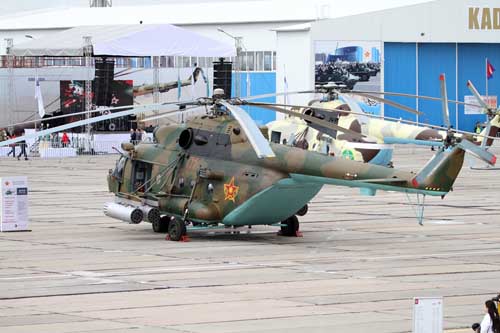
Kazakhstan has ambitious plans to
beef up its military, and defence contractors are more than willing to
oblige.
Buyers and sellers gathered together at the recent defence expo,
KADEX. In addition to buying new weapons.
Kazakhstan also hopes to manufacture them in the near future
Like all post-Soviet countries, Kazakhstan's military is armed primarily
with Russian and Soviet equipment. But it's trying to diversify its
sources for armaments, part of a broad foreign policy that Nazarbayev
calls “multivector diplomacy,” or balancing relations with various
powers so as to not be too dependent on one. And the defence expo, KADEX,
is an attempt to stimulate business with new partners. While Russian
companies are still the dominant foreign exhibitors at KADEX, they're
not the only player in town.
There where so many Turkish companies that they have their own pavilion,
and Israel is also well represented. Airbus contributed with its C-295
and A400M military transport planes and
Russia’s showcased its multi-role Su-30SM and MiG-35 fighter aircraft.
.
Two Airbus Helicopters EC145s from Kazakhstan where displayed at this
year’s KADEX defence exposition. The helicopters, one operated by the
Ministry of Defence and another with the Ministry of Emergency
Situations, are part of 45 twin-engine rotorcraft being acquired by the
government.
This fleet build-up is supported by Euro copter Kazakhstan Engineering,
a joint venture of Airbus Helicopters and the Kazakhstan Engineering
state company, which assembles EC145s and is developing local
maintenance and training capabilities to support their operations in the
country, as well as across the region’s new Eurasian Economic Community
customs union and throughout central Asia.
|
|
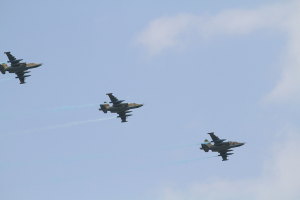 |
|
Su-25s displaying the colours of the
Kazakhstani flag
|
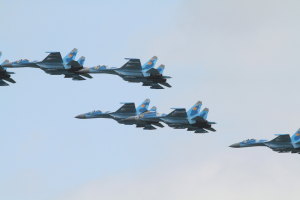 |
|
A formation of
Su-27s, gave a distant display over the edge of the airfield
.
|
Kazakhstan
Kazakhstan is by far the largest of the
Central Asian states of the former Soviet Union. It has borders with
Russia, China, and the Central Asian countries of Kyrgyzstan,
Uzbekistan, and Turkmenistan. Kazakhstan gained its independence from
the former Soviet Union on 16 December 1991. In 1998, the capital was
moved from the south eastern city of Almaty to the northern city of
Astana .
Kazakhstan possesses vast reserves of natural resources and fossil
fuels, many of which are untapped. Globally, Kazakhstan ranks in the top
ten countries for coal, oil, gas, chrome, zinc and bauxite reserves.
Kazakhstan possesses about 19 per cent of world uranium reserves, eight
per cent of zinc, seven per cent of manganese and four per cent of iron
ore. A Steadily rising natural gas production has turned
Kazakhstan from a net importer to a net exporter over the past few years
Kazakhstan inherited nuclear-tipped missiles, a nuclear weapon test
site, and biological and chemical weapon production facilities when the
Soviet Union collapsed. In its first decade of independence, Kazakhstan
dismantled and destroyed Soviet weapons systems and facilities left on
its territory, and signed major international non-proliferation treaties
A other legacy from the cold war period is the active space industry in
Kazakhstan and the inherited Baikonur Cosmodrome from the Soviet Union.
Baikonur is used for international space launches, including all Russian
launches to the International Space Station (ISS). Additionally, Russia
leases a segment of the Baikonur Cosmodrome for ballistic missile
testing
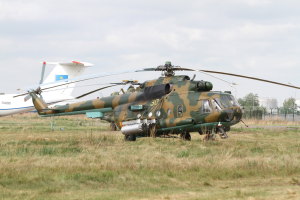
In the late 1980s - early 1990s. with
the collapse of the Warsaw Treaty Organization and the implementation of
the Treaty on Conventional Armed Forces in Europe, the Soviet Air Force
fleet has undergone a significant reduction. Following the dissolution
of the Soviet Union in December 1991,aircraft and personnel of the
Soviet Air Forces – the VVS were divided among the newly independent
states. Russia received the majority of the most modern fighters and 65%
of the manpower. The major commands of the former Soviet VVS – the Long
Range Aviation, Military Transport Aviation and Frontal Aviation were
renamed, with few changes, Russian VVS commands. However, many
regiments, aircraft, and personnel were claimed by the republics they
were based in, forming the core of the new Kazakhstani air forces.
|
Participating in de demo
|
 |
|
The multi-role
SU-30SM. |
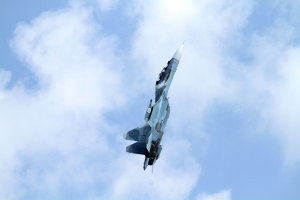 |
|
A An-74
tranport.
|
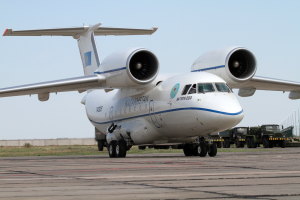 |
|
The Mi-17 from
the boarder guard.
|
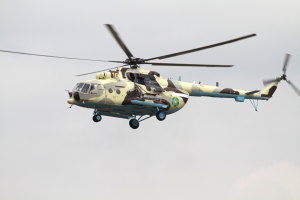 |
Economic power
Kazakhstan has ambitions to not only buy weapons, but to sell them as
well. Kazakhstan also wants to diversify its economy, so that it's not
too dependent on oil and gas. And the armaments industry is one of the
sectors it has chosen to promote. It has a defence industry left over
from the Soviet period, but it is small and its products far from
cutting-edge. So Kazakhstan is enticing foreign companies to set up
joint ventures with local firms, building factories in Kazakhstan and
getting the foreign engineers to train local staff and to offer up their
blueprints so that Kazakhs will eventually be able to build the
armaments themselves.
It's not a setup the foreign companies relish – they make more money by
simply selling equipment directly. But Kazakhstan's growing wealth has
led to ambitious military modernization plans, and foreign firms see a
potentially lucrative market. And it's a measure of Kazakhstan's clout
that the companies are buying in. Next to the airfield where KADEX is
being held, a brand new factory has rising up, painted with a sign
reading “Eurocopter Kazakhstan Engineering.” It's a joint venture
between the European helicopter manufacturer and Kazakhstan's
state-owned defence holding company.
And there is much more such cooperation: French firm Thales is making
military communications equipment, Turkish company Aselsan night-vision
devices and Spanish firm Indra radars – all in Kazakhstan.
The Caspian Sea, bordering four ex-Soviet states and Iran, has become
known over the past twenty years as the site of significant new oil and
natural gas discoveries. But more recently, the sea has seen a quiet
arms build-up as well. Every one of the littoral states has made
significant moves to bolster their naval might (in the cases of
Azerbaijan, Kazakhstan and Turkmenistan, building navies from scratch)
explaning the amount of navel contractors at KADEX 2014.
Kazakhstan is one of the largest operators of Russian-made helicopters
in the region. The republic's armed forces, police, and rescue services
operate all the main models of helicopter produced by Russian
Helicopters: the military transport and search and rescue configurations
of the Mi-8/17 series, the Ka-32A11BC coaxial multirole helicopter, the
Mi-24V gunship helicopter and the Mi-26(T) heavy transport helicopter.
So Russia is aming to sell its latest versions of helicopters at the
show.
KADEX isn't only about business, it's
also a chance for the government to show off its growing might to its
citizens. The final two days of the expo was open to the public, and
some Kazakhstan's people came the airfield, admiring the high-tech
foreign gear and posing for photos next to their country's tanks and
helicopters. Fighter jets did aerobatics and Kazakh paratroopers showed
off their manoeuvres in a display of force .
During the air show several government transport arrived at Astana
airport. Including where these two Tu-134 a aircraft type not often
seen in the western part off Europe, let alone two Kazakhstani
government one's .
In contrast to the previous years the static was not filled with the
different fighter types of the Kazakhstan Air Force. This year the
static was more tuned to the sale part of the show a logical thing for
the organisers. But disappointing for the aviation enthusiast that came
from all over to see the show, de distant flying display made things not
much better.
|